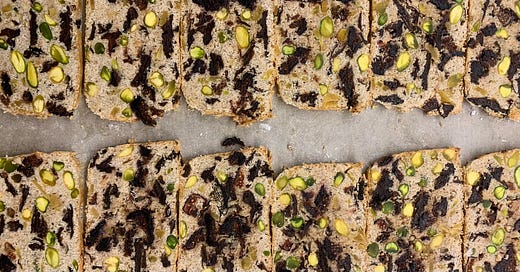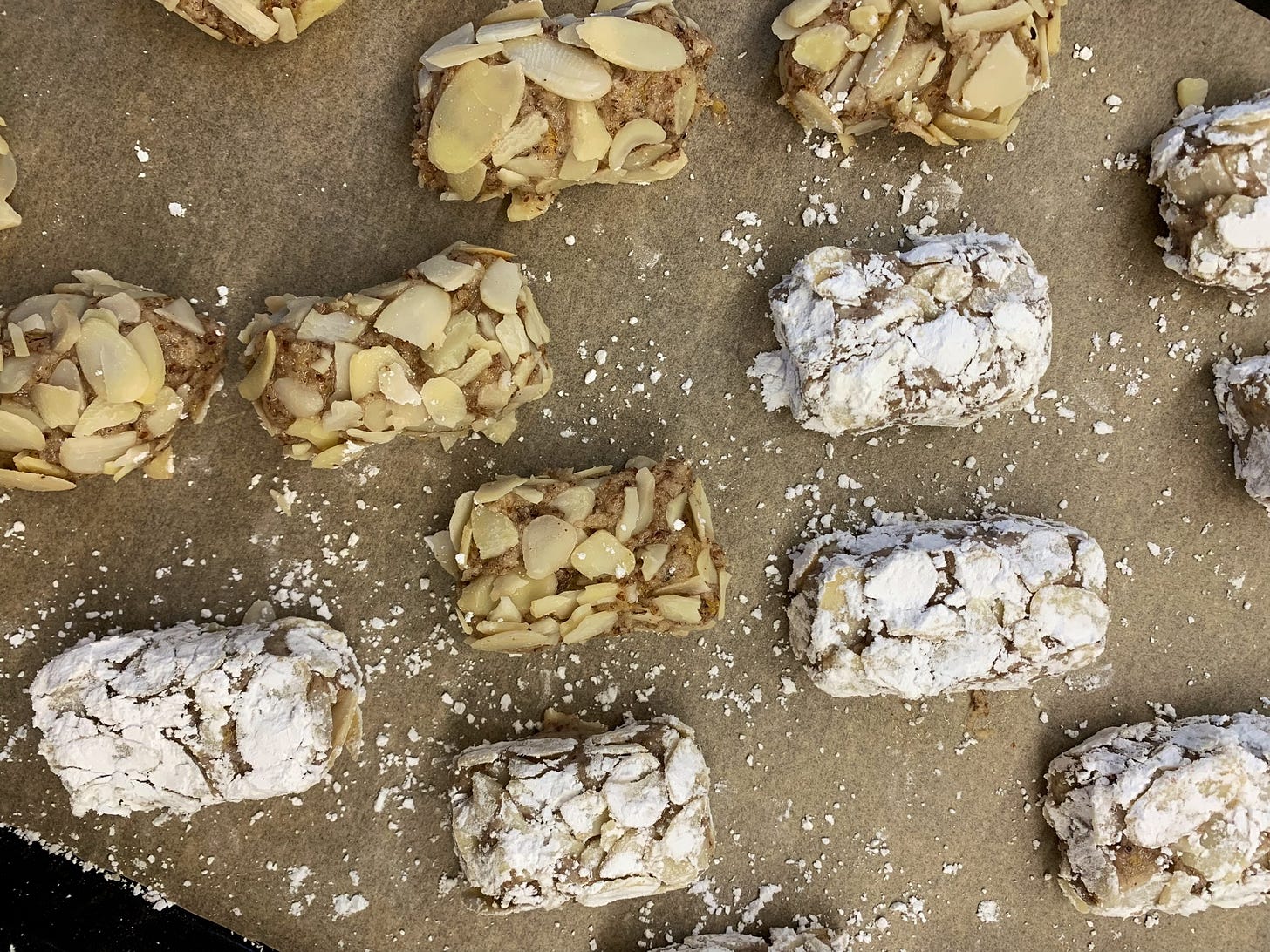December '24 - Christmas biscuits for an egg white overflow.
Tonka Bean & Orange Amaretti and Ginger, Fig & Pistachio Zwieback.
Hello from NL 62. This is Bake Sense. A space to champion flavour and the thoughtfulness of knowing your ingredients well. It’s a place that welcomes interaction, a hopeful extension of life beyond my bakery, Nova Bakehouse, where we’re in the business of baking at a human scale for resilience with hands, hearts and minds. You can view a whole host of recipes shared in previous newsletters in the Recipe Index.
Egg whites are an ever-present part of bakery life; any avid home baker will know this, too. There is never a time when there is not a jar of egg whites in my fridge and an overflow stashed in the freezer, thankfully they come into their own during biscuit season and over the years, my notebook has become filled with enough joyous ways to use them that they seem more like a gift than a glut.
Today, I’m sharing two recent additions to that notebook, which will become heavily annotated with more ideas and thoughts on how I’ll riff on them for years to come.
Tonka Bean & Orange Amaretti
Amaretti recipes abound, and their history dates back to the 18th century, with varying ratios of sugar to almonds and egg whites. After much experimenting, I’ve settled on the below as my preferred quantities. The starting point was the Amaretti biscuit recipe in Sweet by Ottolenghi and Helen Goh. My adaptations are very minimal; I favour a fraction less sugar to account for the amount of icing sugar dusted on post-bake and like to grind a portion of the almonds from unblanched whole almonds for both flavour and texture (see notes below). This is optional; use what you like and have access to.
Amaretti is so named after the word Amaro, meaning bitter in Italian, the bitter element traditionally being bitter almond, which provides aroma and a counterweight to the sugar. However, consider alternative ways to balance the sweetness with complex or intriguing flavours. This iteration looks to the spicy, floral flavour of tonka bean accompanied by orange zest.
You can also try replacing the ground almonds with a proportion of another ground nut; take ground walnuts, for example, which, when paired with Nocino, would be delicious. Or introduce a note of bitterness with mix-ins such as cacao nibs or finely chopped candied grapefruit.
Ingredients
180g ground almonds*
2g sea salt
110g golden caster sugar
Finely grated zest of 1 orange
¼ tsp grated tonka bean
80g egg white
20g honey
120g flaked almonds to coat
Icing sugar for dusting pre and post-bake
* 90g ground almonds (typically blanched) and 90g finely ground from whole unblanched almonds. Grind the whole almonds as finely as possible (it won't be as fine as typical ground almonds or almond meal, but that is the point; it lends a different texture.
Heat the oven to 160 degrees C (fan) and line a baking sheet with parchment.
Combine the ground almonds, sea salt and caster sugar in a bowl. Add the tonka bean and orange zest, and rub the ingredients together with your hands. The abrasiveness of the sugar will help distribute the oils from the zest and further combine them with the natural oils in the nut. (Remember, fat carries flavour, so this is an opportunity to let flavour and fat mingle).
Next, make a meringue by combining the egg whites with the honey in a spotlessly clean bowl. Use a free-standing or a hand mixer to whisk until the whites are firm.
Add the fragrant almond, sugar and zest mixture to the whites and fold to form a sticky paste.
Spread the flaked almonds out on a dinner plate or in the base of a shallow bowl. Take another bowl and sift in 6-7 tablespoons of icing sugar.
Portion the paste into 20-22g using your hands of a mini cookie scoop, then shape into an oblong or lozenge shape (a little water can be helpful here to dip your fingers in to prevent too much mixture from sticking to your hands), and drop them into the flaked almonds, rolling them to coat. Transfer the coated portions to the bowl of icing sugar and gently toss until they’re powdered all over, akin to a snowball.
Place the coated and dusted portions onto a baking sheet.
Bake in the oven for 15-16 minutes until barely golden. The exterior will feel dry to the touch but remain light in colour. You should get the sense that beyond this thin crust, the inside is still soft and chewy.
Remove from the oven and dust with a little more powdered sugar.
Ginger, Fig & Pistachio Zwieback
Zwieback translates as twice bake. The act of twice baking a dough made with cereal grain (plus any number of other ingredients from, at its most basic, water to the enriching flavour and texture-enhancing sugars, fats and eggs) is as old as time itself and has given us so much, from crackers and crispbreads to biscuits that allowed us to discover the world and sweet treats to mark occasions and festivities.
These are the kind of biscuits that can be made well in advance, and now is never too soon. They store well in an airtight box for weeks, the flavour pathways you can walk are endlessly variable, and they look appropriately jewel-like for the season.
Unlike biscotti, which can use whole eggs or egg whites, zwieback recipes tend to use only egg white with no additional fat; this makes for a dry, hard crunch, perfect for dipping in a drink of your choosing, from hot chocolate to wine and stripped back versions, sans nuts and dried fruit are typically served in a bowl with milk, where they become a sweet porridge for infants. This version takes the creative licence to add melted butter and honey, which tenderises and softens the crunch.
Ingredients
28g butter, melted
1 tbsp honey
135g egg white
1g sea salt
45g golden caster sugar
125g wholemeal flour
80g pistachios
40g candied ginger
75g dried figs
75g dried plums
Prepare a small loaf pan by lightly greasing and lining it with parchment paper across the width of the pan, leaving an overhang to act as a sling to remove the biscuit loaf easily.
Heat the oven to 160 degrees C.
In a small saucepan heat the butter until just melted and add the honey, stir to combine and set aside, you want it to stay warm and fluid.
With a free-standing mixer or electric hand whisk, create a meringue by whisking the egg whites and salt to a firm peak; begin adding the sugar a tablespoon at a time until the meringue is thick and glossy.
Fold through half of the flour before adding the remaining half along with the nuts, ginger and dried fruit. Mix with a light hand to incorporate, then add the still fluid butter and honey. Finish folding through to distribute the mix-ins evenly.
Turn the mixture into the prepared tin, spread out to evenly fill the space and level the top. Bake in the oven for 30-40 minutes until the loaf feels firm, and a skewer inserted comes out clean. The time it takes depends on the density and moisture content of the mix-ins, so keep that in mind.
Remove from the oven and allow to cool overnight or for a minimum of 3-4 hours. This gives the structure a chance to set and firm up so it is more stable to slice thinly before the second bake.
Once rested, use a large serrated knife to slice the loaf into thin slices, aiming for 2mm thick or thereabouts. Lay the slices on parchment-lined baking sheets and return to the oven at 100 degrees C until dry and crisp. You can also do this step in a dehydrator, which can help preserve the colour of vibrant pistachios, but it does take a little longer and is by no means necessary.






Thank you! Just perfect right now!